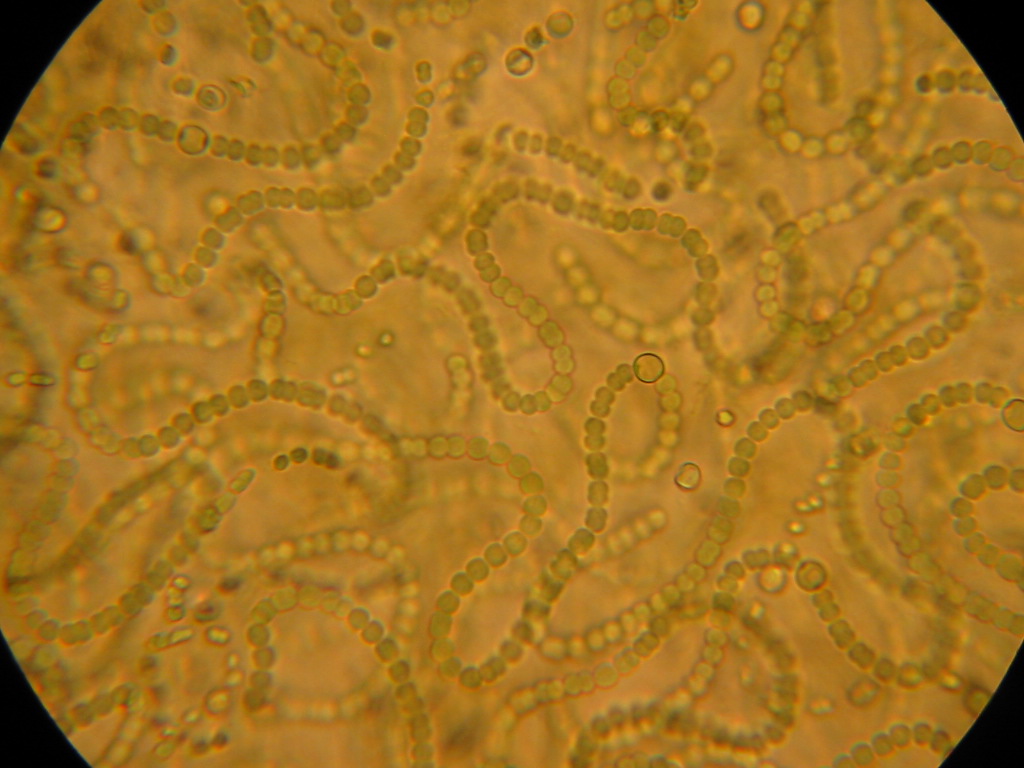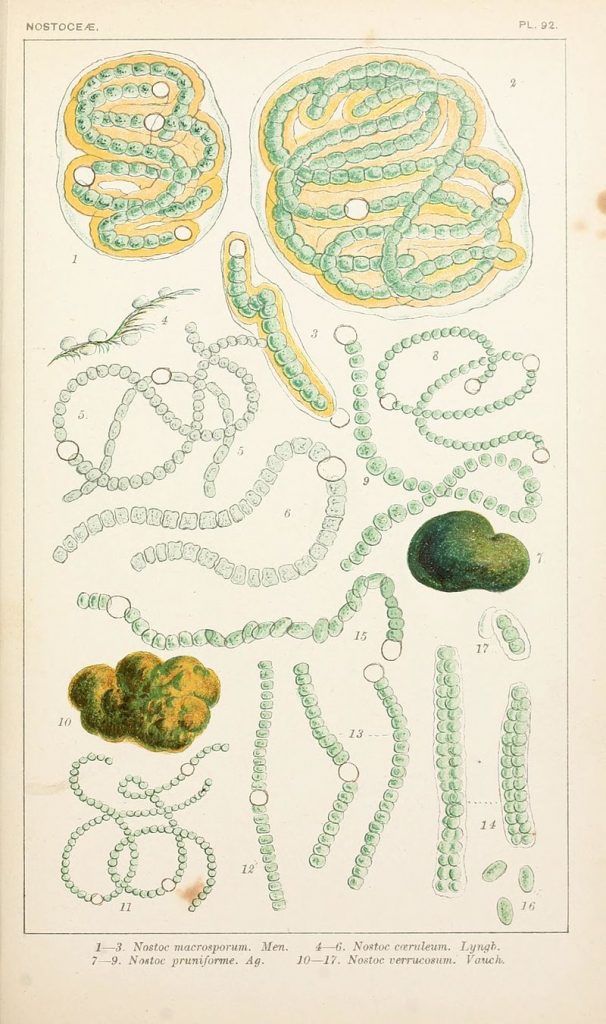Nostoc: the smallest multicellular organism

Nostoc is a genus of cyanobacteria that is common in a variety of habitats: soil, ponds and growing on the surface of rocks and soil if they are kept moist. It also lives symbiotically inside of other organisms. Because of its ability to metabolize nitrogen (see below) it can be significant to ecosystems and to the organisms it associates with. As discussed in Chapter 5 it might be considered multicellular because it has multiple cell types that communicate and cooperate with each other.
Phylogeny
Nostoc is in the group with the common name ‘blue-green algae’, a group often called cyanobacteria. In a five-kingdom classification they are in the Kingdom Monera, Phylum Cyanobacteria. In other classification systems they may be put in Domain Eubacteria, Kingdom Bacteria, Phylum Cyanobacteria. Cyanobacteria are thought to be the endosymbiont that became the chloroplast of eukaryotic photosynthetic organisms.
Structure
Cyanobacteria occur in a number of forms: single cells, filaments and groups of cells in a variety of colonial shapes. Nostoc are filamentous with roughly spherical cells. In addition to the normal cells, they also produce two larger specialized cell types: heterocysts, which are cells specialized to fix nitrogen; and akinetes, which are a type of spore that is resistant to environmental extremes. Cyanobacteria, like gram negative bacteria, have a layer of peptidoglycan sandwiched between and inner and outer membrane. However, the peptidoglycan layer is much thicker in cyanobacteria than typical gram negative bacteria. Nostoc typically produces a large amount of polysaccharide mucilage that forms a sheath around the filaments and occasionally form hollow balls and other amorphous shapes that are up to several cm in size.

Sex and reproduction
Like all bacteria, Nostoc are not sexual but they are capable of exchanging genetic material by other means. Reproduction is solely asexual. In addition to simply producing new cells by cell division, they also produce akinetes, an enlarged cell that because it is tolerant of desiccation and other extremes it can therefore be dispersed through unfavorable space or unfavorable times
Matter and energy
Nostoc and the cyanobacteria are an important group of organisms that ‘can do it all’, being able to acquire both carbon (via photosynthesis) and nitrogen (via nitrogen fixation) from the atmosphere. Nitrogen is acquired by the reduction of dinitrogen gas into ammonia that is subsequently used in forming amino acids. Although they lack chloroplasts, their photosynthesis is basically the same as that found in eukaryotic organisms and it produces oxygen. More so than most organisms, they can ‘live on their own’, acquiring carbon and nitrogen with out requiring the intermediaries of other organisms.
Interactions
Nostoc forms associations with several plants, including hornworts (a group of non-vascular plants), liverworts, ferns, and some flowering plants. Nitrogen fixation by Nostoc can be an important source of nitrogen in soils that are young and have few plants growing on them and therefore little nitrogen availability via the normal route, i.e. as a result of the decomposition of organic material. Nostoc is occasionally eaten by humans, particularly in Asia, although there are some reports of it producing toxins.
Some cyanobacteria can form toxic algal blooms on lakes, causing health officials to close beaches.
On a global scale, cyanobacteria like Nostoc were the cause of the ‘Great Oxygenation Event’ starting about three billion years ago Oxygen produced by the photosynthetic process started to accumulate in the atmosphere, causing a biological catastrophe by eliminating much of the life present at the time whose metabolism was poisoned by oxygen.

Further Reading and Viewing
- “Blue-green Algae (Cyanobacteria) from Pond to Lab – Pondlife, Episode #2” by American Museum of Natural History. Nice video on cyanobacteria.
- “The Origin of Oxygen in Earth’s Atmosphere” by David Biello. Origin of oxygen in the atmosphere.
Media Attributions
- Nostocmicro © Thibul is licensed under a CC BY-SA (Attribution ShareAlike) license
- Nostoc commune © YAMAMAYA is licensed under a CC BY-SA (Attribution ShareAlike) license
- British fresh-water algae © Cooke, M. C. (Mordecai Cubitt) is licensed under a Public Domain license

